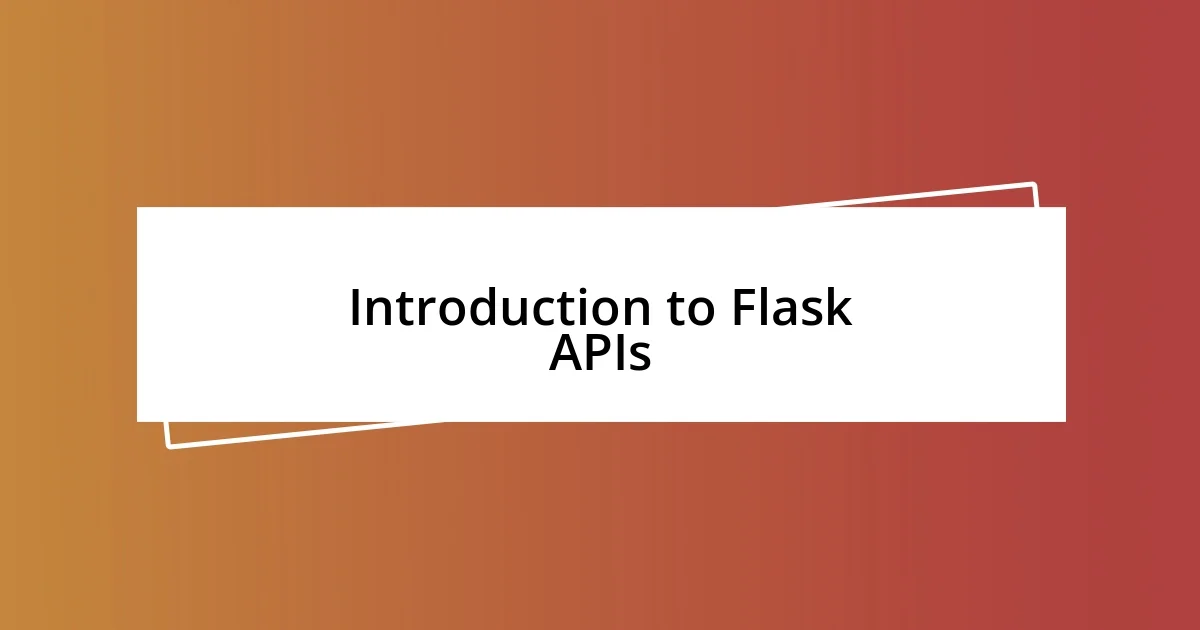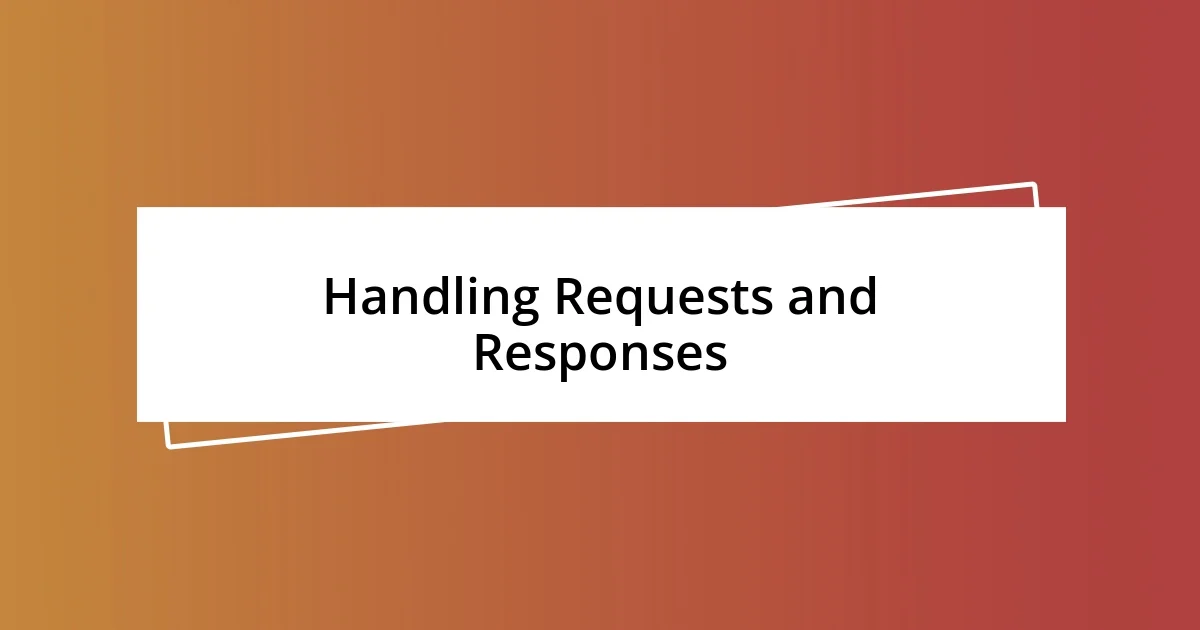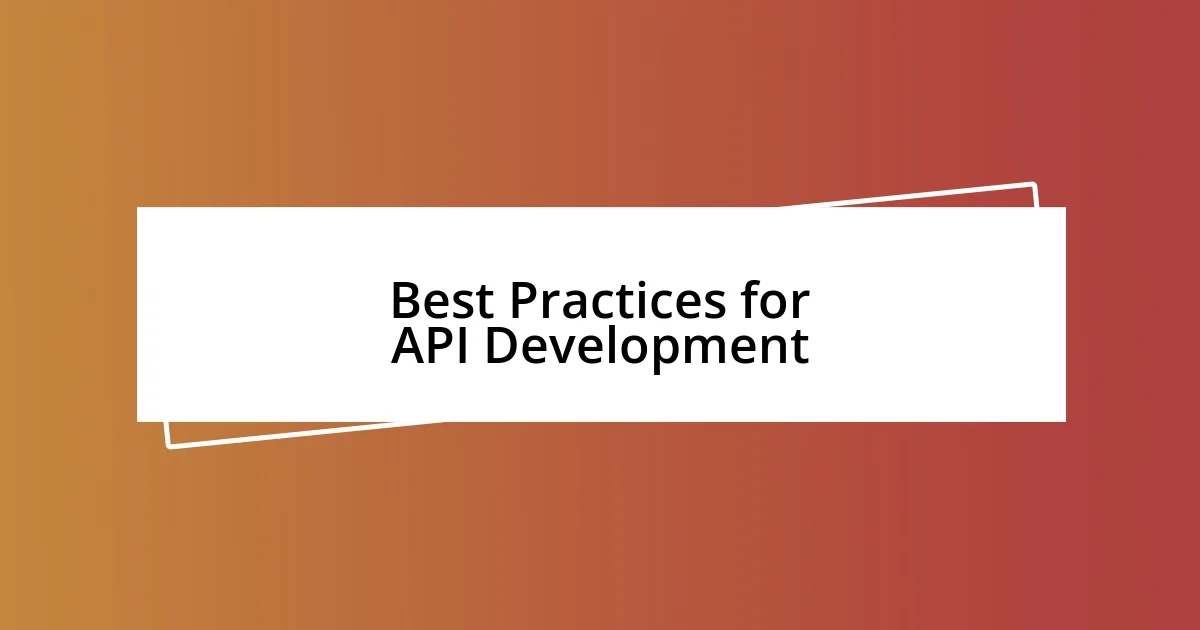Key takeaways:
- Setting up a Flask environment involves installing Python, creating a virtual environment, and installing Flask to lay the foundation for API development.
- Key principles of API design include RESTful structure, consistency in naming and responses, and thorough documentation to enhance usability and collaboration.
- Emphasizing testing strategies and API versioning, alongside implementing security measures, is crucial to ensure robust, user-friendly, and trustworthy APIs.

Introduction to Flask APIs
Flask is a lightweight web framework for Python that makes it incredibly easy to build APIs. I vividly remember my first experience with it; I felt both excitement and a bit of apprehension as I realized I could create a web service from scratch with just a few lines of code. This framework truly empowers developers, allowing for quick prototyping and flexibility, which I find particularly appealing.
When I first dove into building APIs with Flask, it felt like opening a treasure chest of possibilities. Each route I defined and each request I handled was a small victory, reminding me of the satisfaction that comes from seeing code transform into functioning applications. Have you ever felt that rush of accomplishing something new? That’s exactly what I experienced as I learned to harness Flask’s capabilities.
As I explored Flask further, I discovered its robust ecosystem and extensive community support. Equipped with Flask, I felt like a conductor leading an orchestra, coordinating various endpoints and data sources seamlessly. It sparked my curiosity about how different components communicate, and I’ve come to appreciate the elegance of building RESTful APIs that can be both powerful and straightforward.

Setting Up a Flask Environment
Setting up a Flask environment is the crucial first step in your API journey. I remember the mix of excitement and slight intimidation as I entered the command line for the first time, ready to install Flask and set the stage for my application. It was a moment of transformation, like laying the foundation for a house; everything that followed would be built upon it.
To get started with Flask, you’ll need to follow these essential steps:
- Install Python: Ensure you have Python installed on your machine. If you’re unsure, a simple
python --versioncommand in your terminal will tell you. - Create a Virtual Environment: This keeps your project dependencies isolated. Run
python -m venv venvto set one up. - Activate the Environment: Activate it with
source venv/bin/activateon Mac/Linux orvenv\Scripts\activateon Windows. - Install Flask: Use the command
pip install Flaskto install the framework. - Verify Installation: Run a small script or
flask --versionto confirm everything is set up.
These steps might seem simple, but they were monumental for me. As I watched the progress unfold in my terminal, I felt a surge of confidence. Setting up the environment was like preparing my canvas; I was ready to unleash creativity and functionality into the world of web services.

Key Principles of API Design
The key principles of API design revolve around creating an interface that is intuitive, efficient, and easy to use. One of the core principles I’ve embraced is RESTful design, which emphasizes the importance of statelessness and resource-oriented endpoints. When I first implemented this approach, I felt a profound satisfaction in how cleanly my resources became organized. Each endpoint represented a specific dataset, making it much easier for me to visualize and interact with the data.
Another principle I frequently apply is consistency in naming conventions and response formats. I remember the frustration of working with APIs that couldn’t maintain uniformity; it was like deciphering a code without a key. I started adopting a clear and structured approach to naming routes and responses. For example, whether I am returning a list of users or a single user, I ensure that the JSON structure is predictable. This practice has not only helped me but has also made my API easier for others to understand and utilize.
Lastly, I can’t stress enough the importance of clear documentation. My first few projects suffered from a lack of thorough documentation, which often left other developers (and sometimes even myself) scratching our heads. After realizing its value, I made it a habit to document each route, expected input, and output formats. This practice not only streamlines development but also fosters collaboration, as it invites others to contribute to and use my APIs more effectively.
| Principle | Description |
|---|---|
| RESTful Design | Focuses on statelessness and resource-oriented endpoints. |
| Consistency | Maintains uniform naming conventions and response formats for clarity. |
| Documentation | Ensures clear guidelines for route usage, expected inputs, and outputs. |

Implementing RESTful Endpoints
When I first set out to implement RESTful endpoints in Flask, the challenge felt overwhelming. I vividly remember spending hours wrestling with different HTTP methods—GET, POST, PUT, DELETE—and trying to decide when to use each. It wasn’t just about the technical details; it was a transformative moment for me. I learned that each method served a unique purpose, making my API feel more intuitive. For instance, using GET to retrieve data became second nature, but being able to use POST to create a new resource provided a thrill of empowerment.
One aspect that really struck me was how each endpoint became a doorway to my application’s data. I distinctively recall structuring my API around resources, which allowed me to think differently about data organization. Instead of viewing my data as isolated entities, RESTful design taught me to see connections. It felt like creating a comprehensive map of my application, where each endpoint (like /users or /products) played a vital role. Suddenly, implementing CRUD (Create, Read, Update, Delete) operations wasn’t just about functionality; it was about a thoughtful design process that engaged my creativity.
As I gained more experience, I realized that the documentation of these endpoints was equally as crucial as the implementation itself. I recall my early days, scribbling notes, only to find myself lost later on. I quickly adopted the practice of writing concise documentation right after creating an endpoint. It’s a bit like leaving breadcrumbs on a path; it helps guide not only myself but also anyone else who dares to traverse it. It made me ask—what if someone else wanted to use my API but couldn’t understand how? That thought motivated me to ensure my endpoints were not just functional but accessible and well-explained.

Handling Requests and Responses
When I started handling requests and responses in Flask, I often found myself caught off guard by the nuances of different data formats. At first, I assumed JSON was the only way to go, but as I dove deeper, I realized that understanding how to accept and return various formats could significantly enhance user experience. There’s a special satisfaction in crafting responses that truly meet the needs of the requester—I still recall the moment I successfully implemented a method to support both JSON and XML. That flexibility made my API feel more welcoming, like saying, “Hey, I see you; I understand your preferences.”
Error handling also emerged as a crucial component of my API journey. Initially, I underplayed its importance and just returned a bare-bones error message when something went wrong. However, I discovered that a well-structured error response could guide users to the source of the problem. I remember a specific instance where I returned a 404 error for a missing resource, and instead of just saying “not found,” I framed it with additional details. I included hints about what might have gone wrong or what the user could try next. It transformed the response from merely an error to a helpful nudge, and I felt a sense of pride knowing I was supporting users rather than leaving them in the dark.
Finally, the interaction between requests and responses always felt like an ongoing conversation. Each request I processed wasn’t just data; it represented a user’s intention, a question seeking clarity. One day, while reviewing logs, I noticed a pattern in how users were accessing my API. They often combined multiple requests in unexpected ways. This revelation pushed me to think creatively about how I could streamline certain operations—like batching requests—leading me to a significant enhancement in performance. I couldn’t help but wonder, how often do we overlook these subtle interactions that could revolutionize user experience? It’s these moments of discovery that keep me engaged in the art and science of API development.

Testing Flask APIs Effectively
When it came time to test my Flask APIs, I quickly learned that having a solid testing strategy was essential. In my early days, I relied heavily on manual testing, clicking through endpoints with tools like Postman. While it felt like a good start, I often found myself losing track of test cases or forgetting what I had verified. I remember one instance where I neglected to check for edge cases, which eventually led to frustrating bugs in production. That experience was my wake-up call, encouraging me to explore automated testing.
Diving into tools like Flask-Testing and pytest was a game changer for me. I distinctly recall writing my first test case and feeling the thrill of hitting a command that ran all my tests flawlessly. It was empowering to see how a single line of code in a test suite could validate the behavior of an entire endpoint. One memorable moment was when I successfully tested a 401 Unauthorized response for an endpoint that required authentication; it was a testament to the protection I built around my API. I couldn’t help but think about how confident that made me feel, knowing I was not just building, but also fortifying my application.
Incorporating test-driven development (TDD) further enriched my experience. I started to see value in writing tests first, allowing me to define my API’s behavior before diving into the implementation. There was something exhilarating about envisioning a feature and then meticulously creating tests that outlined every expected outcome. It made me deeply consider user interactions and anticipate what could go wrong. Have you ever thought about how empowering it is to write something and know it works as intended right from the start? Those moments of clarity transformed my approach to development and reminded me that each test wasn’t just code—it was a promise made to the users of my API.

Best Practices for API Development
Maintaining clear and consistent documentation throughout the API development process has been another cornerstone of my experience. In the beginning, I took a casual approach to documenting my endpoints, only jotting down key details sporadically. It wasn’t until I received feedback from users struggling to navigate my API that I realized the importance of comprehensive documentation. One day, while chatting with a developer who integrated my API, she pointed out how a single ambiguous term led her down a rabbit hole of confusion. That conversation drove home the point that good documentation can feel like a guiding light, helping users navigate smoothly rather than stumbling around in the dark.
Another best practice I embraced is versioning my API to manage changes effectively. When I rolled out a significant update, I opted for a dramatic shift that inadvertently broke backward compatibility. The users’ frustrated messages made me empathize with them—after all, they relied on my API for their applications. Since then, I’ve made it a priority to implement clear versioning strategies, using paths like /api/v1/resource in my URLs. This allows users to adapt at their own pace while I continue to innovate. Have you considered how a little foresight in versioning can save both you and your users a lot of headaches down the road?
Lastly, security has become non-negotiable in my API development practice. In the past, I often viewed security measures as optional or secondary tasks, but a close call with a potential security breach changed my perspective completely. I remember the anxiety I felt as I uncovered vulnerabilities during a routine code review. That experience forced me to prioritize authentication methods like OAuth and implement rate limiting. Now, I find myself thinking about security proactively—what safeguards can I put in place today to prevent tomorrow’s issues? It’s a constant reminder that API development is not just about functionality; it’s also about protecting the trust users place in your application.














